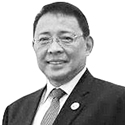
Signs And Wonders
By Diwa C. Guinigundo

Yesterday, the broadsheets reported the approval by President Ferdinand Marcos, Jr. of the proposed P6.793-trillion national budget for 2026. Unfortunately, only the headline figures are available as of press time. It’s good the key message appears to be on the right track. The budget is said to be aimed at improving the quality of education in the Philippines and easing the lives of Filipinos.
But no matter how one looks at it, the proposed budget is still substantial as it is higher than this year’s budget of P6.326 trillion by 7.4%. Next year’s budget is some 22% of the country’s gross domestic product (GDP). After all, the Development Budget Coordination Committee had actually scaled down its growth target from 6-8% to only 6-7%. There should be less fiscal support essential to ensure the target is met. All international financial institutions (IFIs) could only go as far as saying that the global scenario this year and the next would be intractable. Trump’s puzzling tariff policy and the Middle East’s fragile proxy war are wild cards. They are known yet they can go whichever way.
Of course, based on the representation by Malacañang, the current budget proposal had descended from the P10.101 trillion original consolidated budget requests of various agencies and instrumentalities of government. Obviously, and this must be a good rationale, the fiscal space is just limited and therefore over 30% had to be trimmed.
At this point, perhaps Malacañang and Congress should consider the cautionary analysis of the U4 Anti-Corruption Resource Center, an independent, non-profit, multi-disciplinary research institute based on Bergen, Norway that the ideal of the public budget process is rarely met. Such an ideal is the allocation of public resources “in a strategic, transparent, accountable, fair and democratic way.”
Recall that the 2025 budget was previously challenged before the Supreme Court. The petitioners considered it to be the most corrupt budget ever, following the various questionable insertions and politicization of social welfare programs. Nothing was strategic about prioritizing minor and unprogrammed infrastructure projects over public education and public health. Nothing was transparent when the budget outcome was determined by an elite bicameral committee to the exclusion of key players in the budget process. Nothing, or even no one, is accountable when Congress allowed the Finance department to sweep government-owned and -controlled corporations’ (GOCCs) idle funds to cover the unprogrammed appropriations. Nothing is fair and democratic when the so-called idle funds of PhilHealth (Philippine Health Insurance Corp.) were sequestered while the objectives of universal healthcare are barely met; only a small segment of the population and a limited list of health challenges are covered.
It will serve the community’s interest if we hear from the Supreme Court soonest on whether the 2025 budget was a product of a constitutional process. Such a ruling will also be an implicit arbiter of an ideal budget process. Nobody in civil society wants a repeat of the same breach of an ideal budget process in the coming deliberation in Congress after the State of the Nation Address by the President this last week of July.
It will also be interesting to catch the drift of U4’s description of the budget process as “theater” in the worst-case scenario, “with no impact on the real allocation of public money.” U4 was describing the experience in another country where the “theater” actually masked the real distribution of revenues and disbursements.
If the budget process is a theater, let’s see how the Department of Budget and Management (DBM) did the shortlisting of the various requests from P10.101 trillion to P6.793 trillion on the basis of the announced criteria, namely, alignment with the Philippine Development Plan 2023-2028, “shovel-readiness,” absorptive capacity of agencies, and prioritization of programs that deliver the highest value and impact.”
Consider this. Malacañang announced yesterday that “the President himself sat down with the different agencies to ensure that all our priorities are aligned towards our common goal of achieving our vision of a Bagong Pilipinas.” Yet, Budget Secretary Amenah Pangandaman had to reiterate to state agencies “to stick to the agreed budget, and not ask for more once Congress deliberates on the 2026 National Expenditure Program (NEP).”
Is she afraid of the flexibility for theatrical maneuvering in Congress, Senate, and in the bicameral committee?
Ms. Pangandaman’s appeal should no longer be necessary, unless the process of elimination started and ended with her budget staff. By her own admission, though, she also disclosed that she had “been sitting down with department secretaries to check that they agree with their budget levels and priorities.” But Ms. Pangandaman’s appeal reveals a wish “that they won’t ask for more.” If the prioritization involved the agencies themselves at staff, secretary, and no less than the level of the President, what is implicit here is that the DBM itself is afraid the agencies may not keep to what has been agreed upon as to their respective agencies’ budgets. Knowing the officers and members of the Appropriations Committee is as good as having one’s foot in the door of budget additionality.
So, with whom did the President confer in pruning down the budget from P10.101 trillion to P6.793 trillion?
How well will the initial allocations hold?
An agency level breakdown is not yet available, but some other initial figures were disclosed to the public. For instance, maintenance and other operating expenses (MOOE) will get P2.639 trillion or 38.8% of the budget. Other objects of expenditure include personnel services (PS) at P1.908 trillion, or 28.1%; capital outlay, P1.296 trillion or 19.1%; financial expenses, P950 billion. By levels of government, the National Government agencies get P4.305 trillion or 63.4% and local government units will be allocated P1.350 trillion or 20%. GOCCs will be getting P188.3 billion in subsidy or equity support as well as net lending support.
One thing we all know at this point is that the fiscal space is indeed very tight.
In the last four years, the country’s fiscal deficit averaged over P1.5 trillion, with a deficit to GDP ratio ranging from a low of 5.7% in 2024 to a high of 8.6% in 2021. For the first quarter of 2025, the fiscal shortfall remained substantial at 6.8%. In fact, in the first five months of the year, the fiscal deficit already stood at over half a trillion pesos.
How this will be trimmed from a programmed deficit to GDP ratio of 5.5% this year to 4.3% by 2028 may be at best an aspirational target. Revenues have been quite steady at around 15-16% of GDP while expenditures have been way above, at more than 22%. With a presidential elections coming up in three years, it is to the interest of the ruling class to keep expenditure high — for infrastructure to keep the economic momentum strong, social services to develop our human capital and keep the living standards of the Filipinos more decent, for innovation to keep productivity rising and all productivity drags under control, not to mention the cost of winning votes.
But fund sourcing is equally stretched. Public finance is in a bind.
Increasing the tax effort ratio of around 14% of GDP could win or lose elections, especially when the nature of the tax imposed, or the rate to be collected, is not exactly popular. Borrowing could be the measure of last resort, but the National Government’s total outstanding loans are inching towards worrisome levels relative to GDP. Loans rose precipitously from P7.7 trillion before the pandemic to P16.1 trillion in 2024. At end-May 2025, the level further pushed to P16.9 trillion. When all the figures become available for the second quarter, we expect the ratio to exceed 62% of GDP.
Are we prepared then to tax wealth; collect levies on texting; collect on some families’ tax liabilities to the Bureau of Internal Revenue (BIR); clean up the BIR, Bureau of Customs, and other public agencies notorious for corruption, once and for all; prohibit automobile purchases unless people pay for the right to buy, which is anchored on the availability of a parking garage; implement the Supreme Court’s decision on pork barrel; and revise our legal framework on land aggregation and use?
If we are ready to bite the bullet, then we should be prepared to do away with the theatrics in the budget process.
The World Bank’s recent projection about the Philippines’ likelihood of hitting as much as 6.8% annually is not something we simply receive and not do anything to make it happen. If we listen to the World Bank’s presentation, and read carefully the press report, it is quite clear there are at least four reforms we need to do, and this has been the recurrent messages in the government’s report, the IMF Article IV consultation, ADB diagnostics, and in everything else that matters: strengthen infrastructure, improve human capital, enhance competition, and attract more private investment.
Unfortunately, in many of these official reports, one very important ingredient of accelerated, sustainable and innovative development is missing: good governance.
Good governance could very well secure all those reforms at the least cost, and without the theater of the budget process. Let’s get real this time.
Diwa C. Guinigundo is the former deputy governor for the Monetary and Economics Sector, the Bangko Sentral ng Pilipinas (BSP). He served the BSP for 41 years. In 2001-2003, he was alternate executive director at the International Monetary Fund in Washington, DC. He is the senior pastor of the Fullness of Christ International Ministries in Mandaluyong.